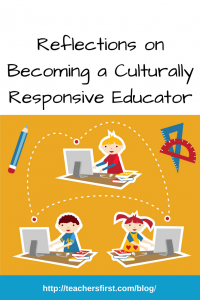 Several years ago, I attended a county training that dealt with recognizing implicit bias and strategies for becoming a more culturally responsive educator. As I walked in the room and thought about my long laundry list of items I needed to complete before the day’s end,
Several years ago, I attended a county training that dealt with recognizing implicit bias and strategies for becoming a more culturally responsive educator. As I walked in the room and thought about my long laundry list of items I needed to complete before the day’s end,
I thought “here we go, another typical training”, but boy was I wrong! It was one the most honest and engaging trainings I’d been to in a long time. It got me thinking about the true importance of working hard to be a culturally responsive educator. We owe it to our students. We owe it to our society. And we owe it to our world. As a world languages teacher, I always took interest in this topic, but as my progression into administration I was able to step back and look at this issue from a more holistic approach and broader lens. Culture is essential to learning. As educators, we need to recognize the importance of students’ cultural references with respect to all aspects of the learning progression.
Now, by no means do I claim to be an expert in this area, but I thinks it’s worthwhile for me to share my major take-aways from this valuable professional development experience:
Educate yourself. Reflect upon your own experiences, culture, upbringing, and biases. Research the topic, join a chat, have the conversation. One thing I learned was that you may have to “go there” with some of the questions and answers… and that’s ok. The reality of your experiences and perceptions may be uncomfortable to talk about, but the truth will guide you toward becoming more culturally responsive in your classroom. I believe that it is important to recognize your implicit biases and reflect on how they influence your teaching expectations and interactions with your students.
Build relationships with your students. Perhaps I should have led with this. I know you’ve probably heard the quote that goes something along the lines of, “No one will remember what you said, but they will remember how you made them feel”. Wow, it’s so true, isn’t it?! Take time to see what interests your students and the experiences they’ve had. You can do this through conversation, writing, activities, clubs… just to name a few! Keep this at the forefront of your mind each day… the little efforts to do this will go a long way in becoming more culturally responsive.
Build a classroom culture of risk-taking and care. Have it your goal to listen to each student’s voice… I guess we should first say to work toward ensuring each student has a voice, right? Create lessons that allow for students to share in different ways and at different times. Create a no judgement zone—for students and for teachers! Have high expectations that are clear and communicated well. And last, but not least, use equitable (not equal) practice, be honest, and be vulnerable.
I will leave you with a quote from Pedro Noguera: “We must teach the way students learn, rather than expecting them to learn the way we teach”. Powerful.

